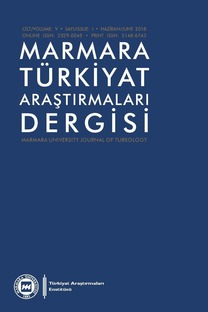HERODOTOS’TA İSKİT TARGİTAOS HANEDANLIĞI KURULUŞ MİTİ ÜZERİNE DEĞERLENDİRMELER
Herhangi bir mit üzerine eleştirel araştırma romantizmin baştan çıkarıcılığını reddeder. Her varyantı veya değişkenin kendine has özellikleri üzerinde ısrar ederek, mümkün olan en iyi derecede ismi bilinmeyen anlatıcılarını tanımlamaya çalışır. Sadece anlatıcı ile bağlantılı olmakla kalmayıp onun ve temsil ettiği toplumsal fraksiyonun çıkarlarını aktif bir şekilde ilerletecek derecede örnek olarak verilmiş olan varyantın detaylarını anlama girişiminde bulunur. Bu bağlamda ilgili miti aktaran yazarın pozisyonunun da gözden geçirilmesi gerekmektedir. Herodotos Historiai (Tarihler) olarak adlandırılan eserinde Skythia’nın da içinde bulunduğu bazı ülkelere seyahat ettiğini bildirmektedir. Onun bu gezilerini, yabancı ülkeler ve gelenekleriyle ilgili deliller toplamak için yaptığı yönündeki öngörünün üzerinde durulması gerekmektedir. Çünkü Herodotos, Hellen kökenli olmayanların da uygarlığa kazandırdığı yenilikler veya icatlar herkes tarafından bilinsin diye araştırmalarını yazıya geçirdiğini bildirmektedir. Bu doğrultuda, eski Hellen-Barbar antitezinin kristalleştiği bir dönemde yaşamasına rağmen, Hellen kökenli olmayan gelenekleri de ilginç bularak değer veren ve hatta öven bir tavır sergilediği görülmektedir. Herodotos, eserinin IV. kitabında özellikle İskit kökenleri, coğrafyası, etnografyası, kültürü ve tarihiyle ilgili muhtemelen kendi gözlemlerinden ve bu ülkede yaşayan Aristeas gibi Hellen yazarlardan faydalanma fırsatı bularak, elde ettiği bilgileri kendisinin de sorguladığı erken dönem Hellen kaynaklarıyla karşılaştırma fırsatı bulmuştur. Herodotos, bir bölümü sözlü kaynağa dayalı ve mitolojik içerikli olsa da, yeri geldiğinde İskitlerin kökeni konusunda daha gerçekçi ve tarafsız bilgiler ortaya koyabilmiştir. Böylelikle kendi ırkının önyargılarını dengelediği söylenebilir. İskit hanedanlığının kuruluşu hakkında iki mit aktarmaktadır. İskitlerin kendileri tarafından aktarılan Targitaos ve bölgedeki Hellen kolonistlerin öne çıkardığı Herakles ve Yılan-Kadın miti. Her iki mitin doğruluğu hakkında tarafsız kalmayı tercih ederek yorumu okuyucuya bırakmaktadır. Bu makalede Targitaos mitini özellikle hanedanlık kuruluşunu temsil eden kraliyet simgeleri bağlamında İran- Sasani edebiyatının başyapıtlarından Şahnâme’den de örnekler vererek tarihi açıdan yeniden yorumlamaya çalışacağız.
RECONSIDERATIONS ON THE ACCOUNT OF THE SCYTHIAN FOUNDATION MYTH OF TARGITAEUS IN HERODOTUS
A critical approach on myth starts by refusing the seductions of romanticism, emphasizing on the particularities of each variant, aiming to identify as best as possible the unnamed narrators, and endeavouring to comprehend the way of the details of a given variant not only correlate with, but actively move forward the interests of the narrator and that fraction of society s/he stands for. From his own statements we learn that Herodotus had traveled through some countries including Scythia. It should be more taken into account that he undertook these journeys simply as a means of collecting evidence for the culture and history of foreign countries and then of using them for writing the History. This is because Herodotus himself points out that his History was also written that the great and wondrous works of non-Greeks may not lose their name. Despite he lived at a period when the Greek-Barbarian antithesis crystallized, he respected and took an interest in the intrinsic values of non-Greeks and was ready to accept foreign cultures on their own terms. Herodotus, especially in his fourth book about the Scythian origins, geography, etnography, culture and history, had held the opportunity to use his own observations and the Greek informants like Aristeas, living in this country, and compared them with the works of early Greek poets and logographers which he did not take for granted. This enabled him to present more credulous, impartial, critical views and informations at times about the origins of Scythians, which seems to have balanced the errors and deficiencies of his race and time. Herodotus cites two myths about the founding of the Scythian dynasty. Targitaeus, transmitted by the Scythians themselves, and the myth of Heracles and the Serpent-Woman brought forward by the Hellenic colonists in the region. He does not comment on the veracity of both myths, preferring to remain neutral, leaving it to the reader. In this article, we will try to reinterpret the Targitaeus myth from a historical point of view, especially in the context of royal symbols representing the establishment of the khanate, by giving examples from the Shahnameh, one of the masterpieces of Iranian-Sassanid literature.
___
- Abe, T., “The Two Orients for Greek Writers”, Kyoto Journal of Ancient History, XI, (2011), s.1-14.
- Baragwanath, E. - Bakker, M. de (ed.), “Introduction”, Myth, Truth, and Narrative in Herodotus, Oxford 2012, s.1-56.
- Berzon, T. S., Classifying Christians: Ethnography, Heresiology, and the Limits of Knowledge in Late Antiquity, California 2016.
